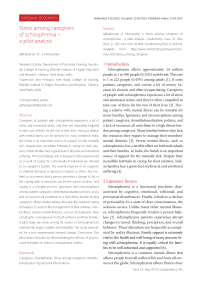Stress among caregivers of schizophrenia - a pilot analysis
Автор: Ajithakumari G., Hemavathy V.
Журнал: Cardiometry @cardiometry
Рубрика: Original research
Статья в выпуске: 22, 2022 года.
Бесплатный доступ
Caregivers of patients with schizophrenia experience a lot of stress and emotional strain, and they are frequently required to take care of them for the rest of their lives. Having a relative with mental illness can be stressful for many families.In India, the family is an important source of support for the mentally sick. Despite their incredible fortitude in caring for their relatives, Indian families face a great deal of physical and emotional suffering. The bad feelings and subsequent strain experienced as a result of caring for a chronically ill individual are referred to as caregiver’s burden. The overall response of an organism to external demands or pressure is known as stress. Any incident or occurrence that a person perceives a danger to his or her coping skills or resources can be the source of stress, and coping is a complex process. Ignorance and misconceptions among patient caregivers, deinstitutionalization policies, and a lack of resources all contribute to a high illness burden among caregivers. Many families believe they lack the required coping techniques to assist in the management of their relatives’ mental illness. Serious mental illnesses, such as schizophrenia, have catastrophic consequences for both sufferers and their families. A pilot study was done among 28 careers of schizophrenia to examine the study’s viability and feasibility. This study advocated for a true experimental research design .Conclusion: This pilot study concludes by demonstrating the efficacy of psychosocial therapies on stress in schizophrenia careers.
Caregivers, schizophrenia, stress among caregivers, deinstitutionalization, psychosocial interventions
Короткий адрес: https://sciup.org/148324626
IDR: 148324626 | DOI: 10.18137/cardiometry.2022.22.435443
Текст научной статьи Stress among caregivers of schizophrenia - a pilot analysis
Ajithakumari G, Hemavathy V. Stress among caregivers of schizophrenia - a pilot analysis. Cardiometry; Issue 22; May 2022; p. 435-443; DOI: 10.18137/cardiometry.2022.22.435443; Available from:
Schizophrenia affects approximately 24 million people or 1 in 300 people (0.32%) worldwide. This rate is 1 in 222 people (0.45%) among adults [1]. It costs patients, caregivers, and society a lot of money because it’s chronic and often incapacitating. Caregivers of people with schizophrenia experience a lot of stress and emotional strain, and they’re often compelled to take care of them for the rest of their lives [2]. Having a relative with mental illness can be stressful for many families. Ignorance and misconceptions among patient caregivers, deinstitutionalization policies, and a lack of resources all contribute to a high illness burden among caregivers. Many families believe they lack the resources they require to manage their members’ mental illnesses [3]. Severe mental illness, such as schizophrenia, has a terrible effect on both individuals and their families. In India, the family is an important source of support for the mentally sick. Despite their incredible fortitude in caring for their relatives, Indian families face a great deal of physical and emotional suffering [4].
-
2 Literature Review
Schizophrenia is a functional psychosis characterized by cognitive, emotional, volitional, and perceptual disturbances. Finally, it leads to a decline of personality. In a state of clear consciousness, the sickness occurs. Unlike many other mental illnesses, schizophrenia frequently renders a person helpless [5]. Schizophrenia patients experience abrupt changes in mood, thinking, perception, and overall behavior. These alterations are frequently accompanied by reality illusions. Family support is extremely vital to the health and well-being of many persons living with schizophrenia. It is equally critical for families to be well-informed and supported [6].
Schizophrenia is a common mental illness that affects people from all walks of life and from all corners of the globe. Schizophrenia affects three to four people out of every 1000 people in any given society [7]. This disease affects about 1% of the general population at some point in their lives. Two-thirds of the cases are between the ages of 15 and 30. The disease is more prevalent among the lower socioeconomic levels [8].
The prevalence rate for schizophrenia is believed to be roughly 1.1 percent of the population over the age of 18 (source: NIMH), which indicates that up to 51 million individuals worldwide are affected by the disease at any given time, including:
China has a population of 6 to 12 million people (a rough estimate based on the population)
India’s population ranges from 4.3 to 8.7 million people (a rough estimate based on the population)
The United States has 2.2 million people; Australia has 285,000 people; and Canada has over 280,000 individuals.
In the United Kingdom, around 250,000 instances have been diagnosed.
Schizophrenia is a severe mental condition that affects a person’s ability to think, feel, and act. People with schizophrenia may appear to have lost touch with reality, causing tremendous distress for the person, their family, and friends [9].
-
3 Materials and Method
-
3.1. The Purpose of This Research
-
3.2. Objectives of the Study
A pilot study was done among 28 caregivers with schizophrenia to examine the study’s viability and feasibility in the analogous procedure as that of the original study in Sree Balaji Medical College and Hospital. Eventually data was anatomized to find out the felicity of the statistics [10].
The goal of this pilot study in Sree Balaji Medical College and Hospital, Chennai, was to see how successful psychosocial interventions were at reducing stress among caregivers of schizophrenia patients [11].
-
• To determine the preassessment level of stress among caregivers of schizophrenia in experimental and control group
-
• To assess and compare post assessment level of stress among caregivers of schizophrenia in experimental and control group.
-
• To compare the effectiveness of psychosocial interventions between experimental and control group
436 | Cardiometry | Issue 22. May 2022
-
• To determine the relationship between demographic characteristics and the post-assessment level of stress in the experimental group.
-
4.1. Research Approach
The term “research approach” refers to the general technique for conducting research. (Treece & Treece, 1986).The selection of research approach is a basic procedure to conduct a research study. The investigator evaluates the effectiveness of psychosocial interventions among caregivers of schizophrenic patients based on the problem chosen for the study and the goal to be achieved, so the quantitative evaluative exploration approach was considered as an appropriate exploration approach for this study [12].
-
4.2. Research Design
-
4.3. Variables
-
4.4. Sample
-
4.5. Criteria for Sample Collection
-
4.6. Inclusion Criteria
-
• The care givers of clients diagnosed with schizophrenia having a history of illness for 6 months or more.
-
• The care givers who were willing to share in this study.
-
• The care givers who speak and understand Tamil or English.
-
• The care givers who belong to the age group of 1860 times will be included.
-
• The caregivers who were willing to come for follow up
-
-
4.7. Exclusion Criteria
Research Methodology
This study advocated for a true experimental research design.
The study’s demographic factors include age, religion, gender, level of education, and patient relationship. Income sufficiency, work position, and caregiver’s duty duration are all factors to consider. As a result of their caring obligations, many have lost their jobs. Marriage status, residence, and family type are all factors to consider [13].
Caregivers of schizophrenia who satisfied the addition criteria were named as samples
The samples for the study were grounded on the succeeding criteria
Care givers of other psychiatric conditions will be excluded from the study.
The care givers who are having any hearing difficulty were excluded from the study
-
4.8. Research Tool and Technique
-
4.8.1. Part I
-
-
4.8.2. Part II
Zarit Burden interview was used to determine the stress levels among the caregivers of schizophrenia. This tool was developed by Steven H Zarit and Judy M. Zarit (1983, 1990)
-
4.9. Considerations of Ethics
It included a structured interview companion with questions about the demographic data of the caregivers of schizophrenic case.
The intended study was carried out with the approval of the Sree Balaji Medical College and Hospital’s institutional ethics commission. Authorization was attained from the Head of the Institution [14]. Due concurrence was attained from the Dean of Sree Balaji Medical College and Hospital and the head of the Psychiatric department for the airman study [15]. Informed concurrence of each sample was attained before the data collection and assertion was given to them that the obscurity of each existent would be maintained [16].
In Table 1 the researcher explains about the demographic variable, 42.86% belong to 18-30 years,71.43% Hindu,64.29% female in experimental group where as in control group 35.71% belong to 18-30 years, 64.29% Hindu, 57.14% female.
In Table 2 Prior to psychosocial therapies, 71.43 percent of careers in the Experimental group had a moderate level of score, while 28.57 percent had a severe level of score. In the control group, 78.57 percent
Table 1
Demographic Profile.
|
Demographic variables |
Group |
||||
|
Experimental (n=14) |
Control(n=14) |
||||
|
n |
% |
n |
% |
||
|
Age |
18-30 years |
6 |
42.86% |
5 |
35.71% |
|
31-40 years |
3 |
21.43% |
5 |
35.71% |
|
|
41-50 years |
3 |
21.43% |
2 |
14.29% |
|
|
51-60 years |
2 |
14.29% |
2 |
14.29% |
|
|
Religion |
Hindu |
10 |
71.43% |
9 |
64.29% |
|
Muslim |
2 |
14.29% |
2 |
14.29% |
|
|
Christian |
2 |
14.29% |
3 |
21.43% |
|
|
Gender |
Male |
5 |
35.71% |
6 |
42.86% |
|
Female |
9 |
64.29% |
8 |
57.14% |
|
|
Level Of Education |
Illiterate |
4 |
28.57% |
4 |
28.57% |
|
Elementary |
3 |
21.43% |
5 |
35.71% |
|
|
Secondary |
7 |
50.00% |
5 |
35.71% |
|
|
High school |
0 |
0.00% |
0 |
0.00% |
|
|
College |
0 |
0.00% |
0 |
0.00% |
|
|
Relationship With The Patient |
Spouse |
7 |
50.00% |
6 |
42.86% |
|
Parents |
4 |
28.57% |
4 |
28.57% |
|
|
Sibling |
2 |
14.29% |
2 |
14.29% |
|
|
Children |
1 |
7.14% |
2 |
14.29% |
|
|
Perceived income adequacy |
Yes |
5 |
35.71% |
4 |
28.57% |
|
No |
9 |
64.29% |
10 |
71.43% |
|
|
Employment Status |
Employed |
6 |
42.86% |
8 |
57.14% |
|
Unemployed |
8 |
57.14% |
6 |
42.86% |
|
|
Demographic variables |
Group |
||||
|
Experimental (n=14) |
Control(n=14) |
||||
|
n |
% |
n |
% |
||
|
Duration of caregivers role |
1-10 years |
9 |
64.29% |
8 |
57.14% |
|
>10 years |
5 |
35.71% |
6 |
42.86% |
|
|
Losing Job because Of Care Giving Responsibility |
Yes |
14 |
100.00% |
14 |
100.00% |
|
No |
0 |
0.00% |
0 |
0.00% |
|
|
Marital Status |
Single |
4 |
28.57% |
2 |
14.29% |
|
Married |
8 |
57.14% |
9 |
64.29% |
|
|
Widowed |
2 |
14.29% |
3 |
21.43% |
|
|
Residence |
Rural |
5 |
35.71% |
6 |
42.86% |
|
Urban |
9 |
64.29% |
8 |
57.14% |
|
|
Type of family |
Nuclear |
5 |
35.71% |
7 |
50.00% |
|
Joint |
9 |
64.29% |
7 |
50.00% |
|
Table 2
Score for the Pretest Level of Stress
In Table 3 After psychosocial therapies, 64.29 percent of careers in the Experimental group had a medium level of score, whereas 35.71 percent have a severe level of score. 85.71 percent of careers in the control group had a moderate level of score, whereas 14.29 percent have a severe level of score.
In Table 4 Pre-test, caregivers in the experimental group scored 57.07, whereas caregivers in the control group scored 56.14, a difference of 0.93. This difference is modest and statistically insignificant. In terms of the post-test, the Experimental group caregivers have a score of 39.86, while the post-test caregivers have a score of 54.43, a difference of 14.57. This difference is big and statistically significant.
In Table 5 Pre-test, caregivers in the experimental group scored 57.07, whereas caregivers in the control group scored 56.14, a difference of 0.93. This difference is modest and statistically insignificant. In terms of the post-test, the Experimental group caregivers have a score of 39.86, while the post-test caregivers have a score of 54.43, a difference of 14.57. This difference is big and statistically significant.
In Table 6 Experimental group the mean stress score before psychosocial intervention was 57.07 whereas after psychosocial intervention it was reduced to 39.86. In control group the mean stress score before psychosocial intervention was 56.14 whereas after psychosocial intervention it was reduced to 54.43.The effectiveness of psychosocial interventions on stress was proved by the reduction of stress score in Experimental group by 19.56% whereas in control group by 1.94%.
In Table 7 the relationship between the post-test level of stress score and caregiver demographic factors revealed that caregivers in the 40-60 year age range, male caregivers, and joint family caregivers have milder stress levels than others. The Chi square test/Yates corrected chi square test was used to determine statistical significance.
In Figure 1 the pre-test level of stress score in the experimental group is 71.43% moderate stress and 28.57% severe stress and in the control group 78.57% moderate stress and 21.43% severe stress.
In Figure 2 the post-test level of stress score in the experimental group is 64.29% mild stress and 35.71% moderate stress and in the control group is 85.71% moderate stress and 14.29% severe stress.
Table 3
Score for the post Test Level of Stress.
|
Stress Levels |
Experimental |
Control |
Chi square test |
||
|
n |
% |
n |
% |
||
|
No stress |
0 |
0.00% |
0 |
0.00% |
χ2=13.88 P=0.001***(S) |
|
Mild stress |
9 |
64.29% |
0 |
0.00% |
|
|
Moderate stress |
5 |
35.71% |
12 |
85.71% |
|
|
Severe |
0 |
0.00% |
2 |
14.29% |
|
|
Total |
14 |
100.00% |
14 |
100.00% |
|
Table 4
Mean Stress Score Pre and Post Test Comparison.
|
Group |
N |
SD |
Mean reduction score |
Paired t-test |
||
|
Experimental |
Pre-test |
14 |
57.07 |
4.07 |
17.21 |
t=11.55 p=0.001*** (S) |
|
Post-test |
14 |
39.86 |
4.89 |
|||
|
Control |
Pre-test |
14 |
56.14 |
3.90 |
1.71 |
t=1.47 p=0.17 (NS) |
|
Post-test |
14 |
54.43 |
5.89 |
|||
Table 5
The Mean Stress Score in the Experimental and Control Groups.
|
Group |
N |
Mean |
SD |
Mean difference score |
Student independent t-test |
|
|
Pre-test |
Experimental |
14 |
57.07 |
4.07 |
0.93 |
t=0.61 p=0.54 (NS) [1] |
|
Control |
14 |
56.14 |
3.90 |
|||
|
Post-test |
Experimental |
14 |
39.86 |
4.88 |
14.57 |
t=7.13 p=0.001*** (S) [1] |
|
Control |
14 |
54.43 |
5.89 |
|||
Table 6
Effectiveness of Psycho social Interventions.
|
Group |
Test |
Maximum score |
Mean score |
Mean Difference of stress reduction score with 95% Confidence interval |
Percentage Difference of stress reduction score with 95% Confidence interval |
|
Experimental |
Pre-test |
88 |
57.07 |
17.21(14.14 –20.29) |
19.56 %( 16.07% –23.06%) |
|
Post test |
88 |
39.86 |
|||
|
Control |
Pre-test |
88 |
56.14 |
1.71(-0.80 – 4.23) |
1.94%(-0.91% –4.80%) |
|
post-test |
88 |
54.43 |
Table 7
Relationship between Caregivers’ Demographic Variables and Post-Test Stress Score (Experimental Group)
|
Demographic variables |
Post-test level of stress score |
n |
Chi square test /Yates corrected chi square test |
||||
|
Mild stress |
Moderate stress |
||||||
|
n |
% |
n |
% |
||||
|
Age |
18-40 years |
5 |
55.56% |
4 |
44.44% |
9 |
χ2=0.83 p=0.36(NS) |
|
41-60 years |
4 |
80.00% |
1 |
20.00% |
5 |
||
|
Religion |
Hindu |
5 |
50.00% |
5 |
50.00% |
10 |
χ2=3.11 p=0.08(NS) |
|
Muslim/Christian |
4 |
100.00% |
0 |
0.00% |
4 |
||
|
Gender |
Male |
5 |
100.00% |
0 |
0.00% |
5 |
X 2=4.32 p=0.03*(S) |
|
Female |
4 |
44.44% |
5 |
55.56% |
9 |
||
|
Level Of Education |
Illiterate |
2 |
50.00% |
2 |
50.00% |
4 |
χ2=0.50 p=0.48(NS) |
|
literate |
7 |
70.00% |
3 |
30.00% |
10 |
||
|
Demographic variables |
Post-test level of stress score |
n |
Chi square test /Yates corrected chi square test |
||||
|
Mild stress |
Moderate stress |
||||||
|
n |
% |
n |
% |
||||
|
Relationship With The Patient |
Spouse |
4 |
57.14% |
3 |
42.86% |
7 |
χ2=0.31p=0.58(NS) |
|
Others |
5 |
71.43% |
2 |
28.57% |
7 |
||
|
Perceived income adequacy |
Yes |
2 |
40.00% |
3 |
60.00% |
5 |
χ2=2.00p=0.15(NS) |
|
No |
7 |
77.78% |
2 |
22.22% |
9 |
||
|
Employment Status |
Employed |
3 |
50.00% |
3 |
50.00% |
6 |
χ2=0.93p=0.33(NS) |
|
Unemployed |
6 |
75.00% |
2 |
25.00% |
8 |
||
|
Duration of caregivers role |
1-10 years |
7 |
77.78% |
2 |
22.22% |
9 |
χ2=2.00p=0.15(NS) |
|
>10 years |
2 |
40.00% |
3 |
60.00% |
5 |
||
|
Losing Job because Of Care Giving Responsibility |
Yes |
9 |
64.29% |
5 |
35.71% |
14 |
χ2=0.00p=1.00(NS) |
|
No |
0 |
0.00% |
0 |
0.00% |
0 |
||
|
Marital Status |
Married |
7 |
87.50% |
1 |
12.50% |
8 |
χ2=2.34p=0.13(NS) |
|
Single/widowed |
2 |
33.33% |
4 |
66.67% |
6 |
||
|
Residence |
Rural |
2 |
40.00% |
3 |
60.00% |
5 |
χ2=1.99p=0.16(NS) |
|
Urban |
7 |
77.78% |
2 |
22.22% |
9 |
||
|
Type of family |
Nuclear |
1 |
20.00% |
4 |
80.00% |
5 |
x 2=6.96p=0.01**(S) |
|
Joint |
8 |
88.89% |
1 |
11.11% |
9 |
||
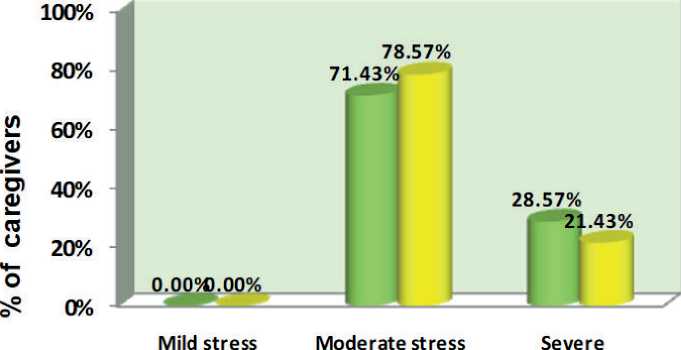
Figure 1. The Pre-Test Level of Stress Score in the Experimental and Control Groups
Experimental
Control
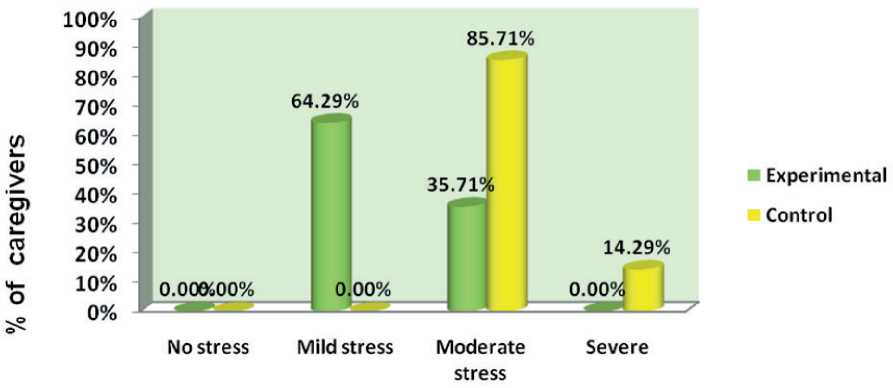
Figure 2. The Post-Test Level of Stress Score in the Experimental and Control Groups
In Figure 3 the association between the post-test levels of stress score and demographic variables of caregivers depicted that male caregivers are having more mild stress level score than others.
In Figure 4 the association between the post-test levels of stress score and demographic variables of caregivers depicted that joint family caregivers are having more mild stress level score than others.
-
4.10. Validity and Reliability
Experts in nursing, medicine, and psychology fought hard for content validity. The Cronbach alpha method was used to assess the tool’s reliability. Coping (0.85) score reliability correlation coefficient These correlation coefficients were extremely high, making it a useful tool for assessing the ef- ficacy of psychosocial therapies on stress among schizophrenia caregivers in a specific hospital in Chennai [18].
-
5 Results and Discussion
-
5.1. Demographic Variable
-
-
5.2. Pre-Test Level of Stress Score in Experimental and Control Group
Most of the caregivers were from the age group of 18-30 years, Hindu and female. Majority of them completed their secondary level of education and their relationship with patient was spouse.
Before psychosocial interventions, in Experimental group, 71.43% of the caregivers were having moder-
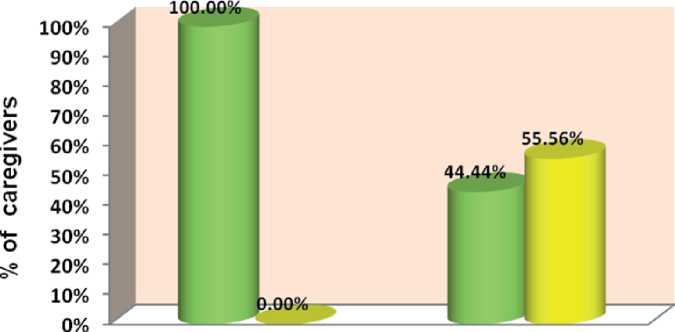
Mild stress
Moderate stress
Male
Female
Figure 3. Relationship between Caregiver Gender and Posttest Stress Score
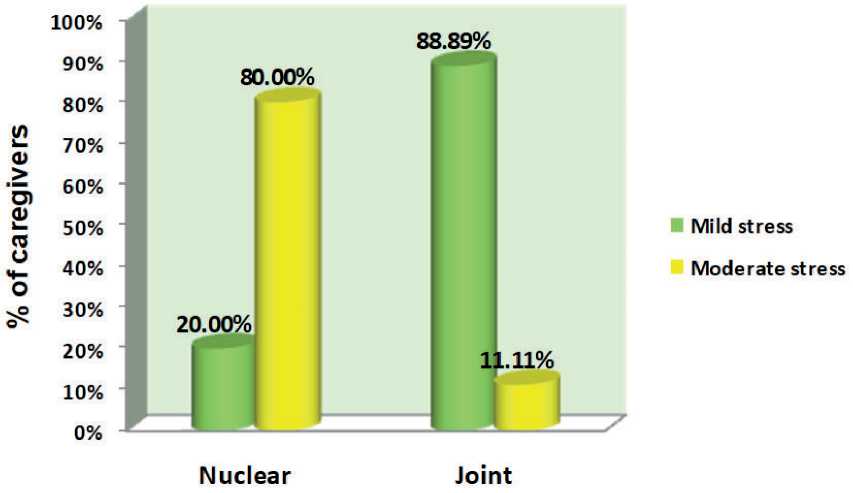
Figure 4. The Relationship between Post-Test Stress Levels and the Type of Family Caregivers
ate level of score, 28.57% of them having severe level of score. In control group, 78.57% of the caregivers were having moderate level of score, 21.43% of them having severe level of score
-
5.3. Posttest Level of Stress Score in Experimental and Control Group
-
5.4. Comparison of Pre-test and Post-Test Mean Stress Score
-
5.5. Comparison of Mean Stress Score between Experimental and Control Group
-
5.6. Effectiveness of Psychosocial Interventions and Generalization of Stress Reduction Score
-
5.7. Association between Post-test Level of Stress Score and Caregivers Demographic Variables (Experimental Group)
After psychosocial interventions, in Experimental group, 64.29% of the caregivers are having mild level of score, 35.71% of them having severe level of score. In control group, 85.71% of the caregivers are having moderate level of score, 14.29% of them having severe level of score
Considering Experiment group, in pre-test they are having 57.07 score and in post-test they are having 39.86 score, so the difference is 17.21 this difference is large and it is statistically significant. Considering Control group, in pre-test they are having 56.14 score and in post-test they are having 54.43 score, so the difference is 1.71, this difference is small and it is not statistically significant.
Considering pre-test, Experimental group caregivers are having 57.07 score and in control they are having 56.14 score, so the difference is 0.93, this difference is small and it is statistically not significant. Considering post-test, Experimental group caregivers are having 39.86 score and in post-test they are having 54.43score, so the difference is 14.57, this difference is large and it is statistically significant
In Experimental group the mean stress score before psychosocial intervention was 57.07 whereas after psychosocial intervention it was reduced to 39.86. In control group the mean stress score before psychosocial intervention was 56.14 whereas after psychosocial intervention it was reduced to 54.43. The effectiveness of psychosocial interventions on stress was proved by the reduction of stress score in Experimental group by19.56% whereas in control group by 1.94%.
The association between the post-test level of stress score and demographic variables of caregivers depicted that 40-60 years group caregivers, male caregivers and joint family caregivers are having more mild stress level score than others. Statistical significance was assessed using Chi square test/Yates corrected chi square test.
-
6 Conclusion
Majority of the caregivers was female from a joint family .Most of the caregivers were residing in urban area. Before psychosocial interventions, in Experimental group, 71.43% of the caregivers were having moderate level of score, 28.57% of them having severe level of score. In control group, 78.57% of the caregivers were having moderate level of score, 21.43% of them having severe level of score.After psychosocial interventions, in Experimental group, 64.29% of the caregivers are having mild level of score, 35.71% of them having severe level of score. In control group, 85.71% of the caregivers are having moderate level of score, 14.29% of them having severe level of score.When comparing the mean stress score in Experimental group, in pre-test they are having 57.07 score and in post-test they are having 39.86 score, so the difference is 17.21 this difference is large and it is statistically significant. Considering Control group, in pre-test they are having 56.14 score and in post-test they are having 54.43 score, so the difference is 1.71, this difference is small and it is not statistically significant. The effectiveness of psychosocial interventions on stress was proved by the reduction of stress score in Experimental group by19.56% whereas in control group by 1.94%.This pilot study concludes by proving the effectiveness of psychosocial interventions on stress among caregivers of schizophrenia.
Conflict of interest nil
Funding nil
Author contributions
The authors read the ICMJE criteria for authorship and approved the final manuscript.
Список литературы Stress among caregivers of schizophrenia - a pilot analysis
- Institute of health Metrics and Evaluation (IHME). Global Health Data Exchange (GHDx (Accessed 25 September 2021)
- EPrints@Tamil Nadu Dr MGR Medical University is powered by EPrints 3 and designed by the Mosys Software Solutions.
- Bharathi.s.batra et al (2015). Coping Strategies Among Caregivers of Patients with Schizophrenia: A Descriptive Study. IOSR Journal of Dental and Medical Sciences (IOSR-JDMS). Volume 14, Issue 12 Ver. VI (Dec. 2015), PP 20-29
- Zarit SH, Orr NK, Zarit JM. The hidden victims of Alzheimer’s disease: Families under stress. New York: New York University Press, 1985
- Ajithakumari.G. (2017).Schizophrenia.International Journal of Current Advanced Research, 6(11): 7098-7101
- Schizophrenia Facts and Statisticshttp://schizophrenia.com › szfacts
- Kamala dailami et al (2015). Caregiver’s stress of psychiatric patients .Journal of Universal College of Medical Sciences, 3(10):39-43
- Ashok Parasar et al (2015). A study of stress caregivers of schizophrenia patients IAHRW International Journal of Social Sciences , 3(3): 354-359
- Bhat et al (2020).Caregiver Burden and Quality of Life in Primary Caregivers of Schizophrenia Patients. Acta Medica International , 7(1):13-18
- Kumar R, Nischal A, Dalal PK, Varma S, Agarwal M, Tripathi A, Kar SK, Gupta B(2020). Impact of brief psychosocial intervention on key relatives of patients with schizophrenia: A randomized controlled trial. Indian J Psychiatry,62(2):137-44
- Jenny Marlindawani Purba and Evi Karota Bukit (2017) The Effect of a Psychoeducation Intervention on Burden among Caregivers of Persons with Schizophrenia.Advances in Health Sciences Research, 1:140-148
- Yasuma N, et al. BMJ Open 2020; 10:e034425. doi:10.1136/bmjopen-2019-034425
- Burden, and Caregiver Depressive Symptoms, International Journal of Mental Health,44(4): 277-289
- Raviteja Innamuri, (2018) Effects of Psychoeducation on knowledge of caregivers of people with Schizophrenia. Master’s thesis, Christian Medical College, Vellore.
- Krishna Leela, S (2016) A comparative study to assess the quality of life among care givers of patients with schizophrenia and mania in selected hospital at Tirunelveli. Master’s thesis, Nehru Nursing College, Vallioor.
- National Institute of Mental Health (2020). Schizophrenia. Retrieved 2020.
- American Psychiatric Association (2022) what is psychiatry.Retrieved 2022.
- Vasa nth Kumar Kasturi (2015) A Study To Assess The Stress And Coping Among Caregivers Of Mentally Ill Patients.International Journal Of Pharmaceutical Research And Bio-Science,4(2): 263-271

